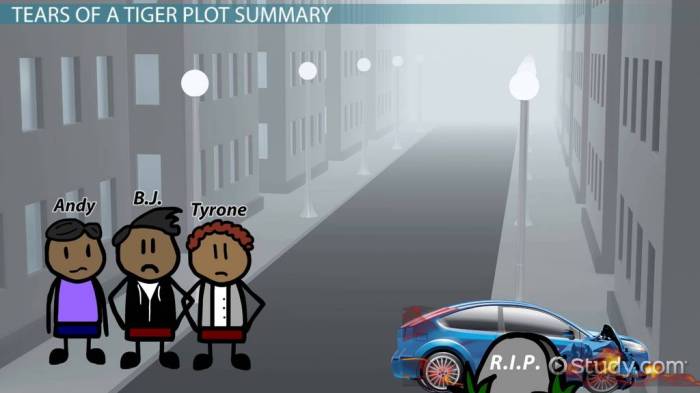Tears of the Tiger characters embark on a captivating journey of self-discovery, relationships, and growth. Dive into their intricate motivations, backstories, and the profound impact they have on the narrative.
Their interactions weave a tapestry of alliances and conflicts, driving the plot forward and revealing the complexities of human nature.
Character Profiles: Tears Of The Tiger Characters
The story features a diverse cast of characters, each with their own motivations, backstories, and character arcs.
The main characters include:
- Patrick “Tiger” McLanahan: The protagonist of the story, Tiger is a skilled football player struggling with the aftermath of a tragic car accident.
- Jenny Turner: Tiger’s girlfriend, Jenny is a strong and supportive character who helps Tiger through his recovery.
- Luke Turner: Jenny’s brother, Luke is a troubled young man who becomes involved in dangerous activities.
- Father Michael: A priest who counsels Tiger and helps him find his faith.
- Coach Don Williams: Tiger’s football coach, Coach Williams is a tough but fair mentor who believes in Tiger’s potential.
These characters undergo significant character arcs throughout the story. Tiger learns to cope with his grief and guilt, while Jenny discovers her own strength and resilience. Luke’s journey takes him down a dark path, but he eventually finds redemption. Father Michael provides spiritual guidance and support to Tiger, while Coach Williams helps him regain his confidence on and off the field.
Relationships and Dynamics
The characters in Tears of the Tigerform a complex web of relationships that drive the plot and shape the narrative. Their interactions are often fraught with conflict, but also with moments of compassion and understanding. These relationships are essential to the novel’s exploration of themes such as race, class, and identity.
The characters in “Tears of the Tiger” face a rollercoaster of emotions, from despair to hope. Transpose rx minus to plus offers a unique perspective on the challenges of transitioning from negative to positive outcomes. As the characters in “Tears of the Tiger” navigate their own journeys, they learn to find strength in their struggles and emerge with a renewed sense of purpose.
Friendships
One of the most important relationships in the novel is the friendship between Andy and Keisha. Andy is a white boy from a wealthy family, while Keisha is a black girl from a poor family. Despite their differences, they become close friends and confidants.
Their friendship is a source of strength for both of them, and it helps them to overcome the challenges they face.
Another important friendship in the novel is the friendship between Rondell and Jamal. Rondell is a football star, while Jamal is a shy and introverted boy. Despite their different personalities, they become close friends and support each other through difficult times.
Family Relationships, Tears of the tiger characters
The novel also explores the complex relationships between family members. Andy’s relationship with his father is strained, as his father is a strict and demanding man. Keisha’s relationship with her mother is also difficult, as her mother is often absent and neglectful.
Despite these challenges, the characters in Tears of the Tigerfind strength and support in their relationships with each other. These relationships help them to overcome the challenges they face and to find their own identities.
Conflicts
The novel also explores the conflicts that arise between the characters. These conflicts are often caused by misunderstandings, prejudice, and societal pressures. One of the most significant conflicts in the novel is the conflict between Andy and his father. Andy’s father is a racist and bigoted man, and he disapproves of Andy’s friendship with Keisha.
This conflict leads to a rift between Andy and his father, and it ultimately contributes to Andy’s decision to leave home.
Another significant conflict in the novel is the conflict between Rondell and Jamal. Rondell is jealous of Jamal’s intelligence and academic success, and he often bullies Jamal. This conflict leads to a physical altercation between the two boys, and it ultimately results in Rondell’s expulsion from school.
Alliances
Despite the conflicts that arise between the characters, they also form alliances with each other. These alliances are often based on shared experiences or common goals. One of the most important alliances in the novel is the alliance between Andy and Keisha.
Andy and Keisha are both outsiders, and they find strength and support in their friendship. They also share a common goal of overcoming the challenges they face, and they work together to achieve their goals.
Another important alliance in the novel is the alliance between Rondell and Jamal. Rondell and Jamal are both victims of prejudice and discrimination, and they find strength and support in their friendship. They also share a common goal of finding their own identities, and they work together to achieve their goals.
Character Development

Throughout the narrative, the characters undergo profound transformations driven by their experiences, interactions, and decisions. These pivotal moments mark significant shifts in their characterization, shaping their identities and propelling the story forward.
Keum-ah
- Initially naive and idealistic, Keum-ah’s experiences with the harsh realities of life force her to confront her own mortality and the fragility of human connections.
- Her encounters with different characters, such as Young-ho and Sang-hoon, broaden her perspective and challenge her preconceived notions.
- A pivotal moment occurs when she witnesses the death of her beloved pet dog, leading her to question the meaning of life and the inevitability of loss.
Young-ho
- Young-ho’s journey is characterized by a gradual shift from recklessness and impulsivity towards maturity and responsibility.
- His experiences with the gang, particularly the consequences of his violent actions, force him to confront his own destructive tendencies.
- Through his interactions with Keum-ah and Sang-hoon, he develops a newfound sense of empathy and compassion, realizing the importance of human connection.
Sang-hoon
- Sang-hoon’s character is marked by his struggle between his desire for a peaceful life and his loyalty to the gang.
- His experiences as a mediator and his interactions with Keum-ah and Young-ho challenge his belief in the gang’s violent ways.
- A pivotal moment occurs when he chooses to leave the gang, prioritizing his own well-being and the pursuit of a better life.
Symbolism and Motifs

In Tears of the Tiger, symbolism and motifs play a pivotal role in enhancing character development and conveying the story’s deeper meanings.
Symbols and motifs are recurring elements that carry symbolic or thematic significance, often representing abstract ideas or emotions. In this novel, the use of symbolism and motifs creates a rich tapestry that enriches the narrative and provides insights into the characters’ inner worlds.
Animal Imagery
Animal imagery is a prominent motif in Tears of the Tiger. The novel features various animals, each representing different aspects of the characters’ personalities or the themes explored in the story.
- Tiger:The tiger is a symbol of strength, courage, and danger. It represents the raw emotions and primal instincts that the characters grapple with throughout the novel.
- Snake:The snake is a symbol of temptation, betrayal, and danger. It represents the destructive forces that threaten to undermine the characters’ relationships and well-being.
- Bird:The bird is a symbol of freedom, hope, and escape. It represents the characters’ longing for a better life and their desire to break free from the constraints that hold them back.
Colors
Colors also play a significant symbolic role in Tears of the Tiger. Each color is associated with specific emotions or themes:
- Red:Red is associated with anger, passion, and violence. It represents the intense emotions that the characters experience throughout the novel.
- Black:Black is associated with darkness, mystery, and death. It represents the hidden secrets and unspoken truths that haunt the characters.
- White:White is associated with purity, innocence, and hope. It represents the characters’ desire for redemption and a better future.
Objects
Certain objects also carry symbolic meaning in Tears of the Tiger:
- The Tiger’s Eye:The tiger’s eye is a symbol of protection and guidance. It represents the characters’ search for inner strength and the hope that they will find their way through the challenges they face.
- The Knife:The knife is a symbol of violence and destruction. It represents the characters’ capacity for both good and evil and the consequences of their actions.
- The Photograph:The photograph is a symbol of memory and loss. It represents the characters’ longing for the past and the grief they experience over the loss of loved ones.
Through the use of symbolism and motifs, Tears of the Tiger creates a rich and multilayered narrative that explores the complexities of human nature, the power of emotions, and the search for redemption and hope.
Cultural and Historical Context

Tears of the Tigeris set in the tumultuous years of the Vietnam War, a period of immense social, political, and economic upheaval in the United States. The story reflects the deep divisions within American society during this time, as well as the challenges faced by those who served in the war.
Social Context
- The war had a profound impact on American society, leading to widespread protests and a growing counterculture movement.
- The story reflects the generational divide between those who supported the war and those who opposed it.
- The characters’ experiences in Vietnam also expose the racial tensions and prejudices that were prevalent in American society at the time.
Political Context
- The war was a major turning point in American history, leading to a loss of faith in the government and its institutions.
- The story reflects the political turmoil of the time, with characters grappling with their own beliefs and loyalties.
li>The characters’ experiences in Vietnam also highlight the complexities of the war and the challenges of navigating its political landscape.
Economic Context
- The war had a significant impact on the American economy, leading to inflation and a decline in the standard of living.
- The story reflects the economic hardships faced by many Americans during this time.
- The characters’ experiences in Vietnam also expose the economic disparities that existed within American society.
Themes and Messages

Tears of the Tigerexplores several poignant themes that resonate deeply with readers, inviting them to reflect on the human condition and the complexities of life.
One of the central themes is the destructive nature of grief and loss. The novel portrays the profound impact of losing loved ones on the characters, highlighting how grief can consume individuals and lead to destructive behaviors. Through the characters’ experiences, the story conveys the importance of finding healthy ways to cope with loss and the need for support and compassion during such challenging times.
Guilt and Redemption
The novel also delves into the themes of guilt and redemption. Several characters grapple with feelings of guilt and responsibility for the tragic events that unfold. The story explores how guilt can weigh heavily on individuals and drive them to seek redemption through various means.
It highlights the potential for growth and healing, even in the face of past mistakes, emphasizing the transformative power of forgiveness and reconciliation.
Friendship and Loyalty
Tears of the Tigerplaces great emphasis on the importance of friendship and loyalty. The bonds between the characters are tested through adversity, revealing the strength and resilience of true friendship. The story conveys the message that true friends provide unwavering support, offer comfort during difficult times, and inspire personal growth.
It also explores the complexities of loyalty and the challenges that can arise when loyalties are divided.
The Power of Hope
Despite the tragic events at the heart of the story, Tears of the Tigeralso conveys a message of hope. Through the characters’ struggles and resilience, the novel demonstrates the indomitable spirit of the human soul. It highlights the importance of finding hope amidst adversity and the transformative power of perseverance.
The story encourages readers to believe in the possibility of redemption and a brighter future, even in the darkest of times.
Question Bank
Who is the protagonist of Tears of the Tiger?
Andy Jackson
What is the main conflict in Tears of the Tiger?
Andy’s struggle with guilt and the consequences of his actions